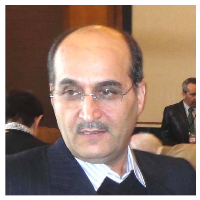Evolution of Arvand Delta (Iranian part) During the Holocene using Sedimentology Evidence
Author(s):
Article Type:
Research/Original Article (دارای رتبه معتبر)
Abstract:
Introduction
Deltas are the most dynamic geomorphological landforms which simultaneously affected by the sea and land processes. A brief survey shows rising and falling of Persian Gulf level water and coastline displacement have been created changes in the boundary of the Arvand Delta distal and The edge of the continental shelf. Arvand delta as the largest delta of Persian Gulf, due to its very low slope in foreshore and the effect of eustatic changes of Persian Gulf and river sedimentation has experienced many changes during the last period of the Quaternary to the present– from applied geomorphology point of view so far has not been studied. The importance of this issue becomes twofold when we know coastal changes are rapidly increasing under the influence of global warming in recent years and the need to investigate the response of coastline against to this approach is inevitable. Therefore, the aim of this study is to achieve the changes and evolution of the Arvand delta during Holocene.
Materials and Methods
In order to achieve the purpose of the research, survey - laboratory instruments and digital - documentary data were used as follows: study of books, articles, dissertations, research projects for general realizing of the subject and case study, area geomorphological map in order to evaluating the now morphological situation and selecting the points of coring, granulometry analysis of 47 sedimentary samples from 7cores (a total of 56 m drilling) in order to detect the size particle above 63 microns using wet sieve shakers and smaller than 63 microns using a laser particle sizer, elemental analysis of 47 sediment samples using inductively coupled plasma method using ICP-OES, mineralogy of 47 sedimentary samples using X-ray diffraction (XRD), dating radiocarbon Using the mass spectrometer accelerator method at Beta Analytic Radiocarbon Dating Laboratory, Florida, USA and finally, the separation and reconstruction of sedimentary environments associated with sea level fluctuations.
Results and Discussions
Separation of sedimentary environments initially was carried out and 3 sedimentary environments from up to down were identified. The variation and sequence of sedimentary environments from the fluvial to the marine is in 3 meters depth on average. Granulometry analysis of 47 sedimentary samples shows study of granulometery cannot correctly do the analysis the sedimentation processes of delta. Elemental analysis of samples shows the amounts of aluminum, chromium, manganese and barium (terrigenous origin) are inversely related to the changes in sea level in this region. Also, change trend in the elements of calcium and strontium (ocean basin) conforms to sea level changes trend. Mineralogy results of samples showed due to the crossing of major rivers flowing to the Arvand delta, especially Karun river from carbonate formations in the Zagros mountains and the geographic location of the Persian Gulf in the semi-tropical climate, the amount of calcium carbonate in the form of calcite, dolomite and aragonite is more than 50% of the total amount of sediment. Evaluation of the dating results after calibration of samples and depth - age graph in the core MR.7 (the southernmost core in the delta distal) shows the average of delta sedimentation rate has been 2.9 mm / yr in 2500 years ago.
Conclusion
Sediments of seven cores in Arvand Delta (Iranian part) using sedimentary evidence not only reveals features of sedimentary environments during sedimentation, but also can be indicative of fluctuations, deceleration and transgression of sea level. The results of sedimentary paleoenvironments reconstruction and delta morphogenesis processes in relation to Persian Gulf sea level changes, from up to down, respectively 3 sedimentary environments identified: fluvial plain, brackish–freshwater marsh and marine (tidal). Geochemical analysis (elemental and mineralogy analysis) of sedimentary samples compared to Granulometry analysis can be show better determine the relationship between sea-level changes with delta progressing in this area. Results of carbon isotope analysis (in order to time reconstruction of sedimentation process) and the isotope of oxygen (in order to reconstruction of past climatic conditions) along with other previous studies (Aqraw, 2001; Bogemans et al, 2016, 2017; Heyvaert and Baeteman, 2007; Lambeck, 1996; Purser, 1973; Sanlaville, 2002 and Shahbazi, 2016) showed Arvand delta due to the interference of active fluvial processes (about 2300 years ago) with progradation and transgression of sea (about 9,000 to 2300 years ago) is formed. Arvand River about 2,300 years ago when the weather was colder than present (-2 /75 °) in response to gradual dropping of sea level had tried to reach itself to the lower basic factorerect factor level (Persian Gulf) with the rate of 3/19 mm/yr.Keywords:
Language:
Persian
Published:
Quaternery journal of Iran, Volume:3 Issue: 12, 2018
Pages:
315 to 329
magiran.com/p1964726
دانلود و مطالعه متن این مقاله با یکی از روشهای زیر امکان پذیر است:
اشتراک شخصی
با عضویت و پرداخت آنلاین حق اشتراک یکساله به مبلغ 1,390,000ريال میتوانید 70 عنوان مطلب دانلود کنید!
اشتراک سازمانی
به کتابخانه دانشگاه یا محل کار خود پیشنهاد کنید تا اشتراک سازمانی این پایگاه را برای دسترسی نامحدود همه کاربران به متن مطالب تهیه نمایند!
توجه!
- حق عضویت دریافتی صرف حمایت از نشریات عضو و نگهداری، تکمیل و توسعه مگیران میشود.
- پرداخت حق اشتراک و دانلود مقالات اجازه بازنشر آن در سایر رسانههای چاپی و دیجیتال را به کاربر نمیدهد.
In order to view content subscription is required
Personal subscription
Subscribe magiran.com for 70 € euros via PayPal and download 70 articles during a year.
Organization subscription
Please contact us to subscribe your university or library for unlimited access!




